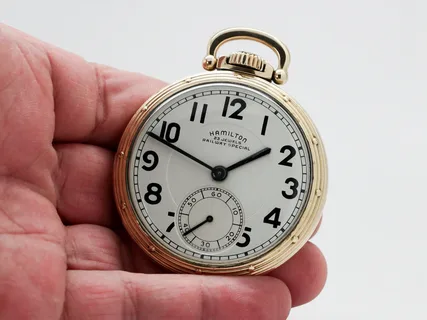The 1912 Hamilton Pocket Watch Grade 990 is a piece of horological history, celebrated for its precision, craftsmanship, and timeless design. As one of the most iconic pocket watches ever made by the Hamilton Watch Company, it holds a special place in the hearts of collectors and enthusiasts alike. Let’s delve deeper into this exceptional timepiece, exploring its history, features, and why it continues to captivate watch lovers even over a century after its creation.
A Legacy of Excellence: Hamilton Watch Company
The Hamilton Watch Company, founded in 1892 in Lancaster, Pennsylvania, quickly became known for its high-quality timepieces, earning the nickname “Watch of Railroad Accuracy.” Hamilton was one of the first companies to produce reliable pocket watches that met the exacting standards of the railroad industry, which demanded precision for safe and timely train schedules. This focus on accuracy helped to cement Hamilton’s reputation as a leader in the American watchmaking industry.
Introduction of the 1912 Hamilton Pocket Watch Grade 990
Released in 1912, the Grade 990 pocket watch was one of Hamilton’s most revered models. Designed for those who needed a durable and accurate timepiece, the Grade 990 epitomized Hamilton’s commitment to quality and innovation. It was crafted to meet the high standards of railroad regulations, ensuring that it was not only a functional tool but also a symbol of reliability and precision.
The 1912 Hamilton Pocket Watch Grade 990 was a lever-set, 17-jewel movement, a significant technological advancement for its time. It was designed to maintain its accuracy even under the most demanding conditions, such as the jolting vibrations experienced on trains. As a result, it became a staple for railroad conductors, engineers, and other personnel who relied on pocket watches to coordinate schedules.
Technical Specifications
- Movement: The Grade 990 is powered by a 17-jewel, manual-winding movement. The jewel count indicates a high level of precision and durability, as the synthetic rubies reduce friction in the gears and improve the overall longevity of the movement.
- Case: The pocket watch is typically housed in a sturdy, durable case, often made of either solid gold or a gold-filled material, offering a premium aesthetic while ensuring protection for the delicate inner workings.
- Dial: The dial of the Grade 990 is simple, yet elegant, with clear Arabic numerals, providing legibility in all lighting conditions. The watch face typically features the classic railroad-style minute markers, which allowed users to read the time quickly and efficiently while on the move.
- Size: The Grade 990 was generally produced in a 16-size case, making it a larger pocket watch ideal for those who needed a visible, easy-to-read timepiece during long hours of work.
Features and Design
The design of the 1912 Hamilton Pocket Watch Grade 990 reflects the aesthetic preferences of its era, combining function with elegance. Its large, open-face dial allowed for easy reading, while the gold case added a touch of sophistication. A key feature of this model was its accuracy. It was considered one of the most reliable pocket watches available at the time, and it was often used by professionals in industries requiring precision.
The Grade 990 also introduced a 21-jewel version, which was regarded as one of the highest-grade movements offered by Hamilton during the period. The 21-jewel variant was prized for its exceptional accuracy and mechanical engineering.
Collectibility and Value
Today, the 1912 Hamilton Pocket Watch Grade 990 is a sought-after collector’s item. Its rarity, quality, and historical significance have made it a prized possession for horology enthusiasts. The watch represents an important chapter in American watchmaking history, particularly as it relates to the railroad industry. Those who collect vintage pocket watches or have a passion for Hamilton’s storied legacy often seek out the Grade 990 to complete their collections.
Prices for a well-maintained 1912 Hamilton Pocket Watch Grade 990 can vary widely, depending on factors such as the condition of the case, movement, and dial. Gold-cased versions tend to fetch higher prices, especially when in mint condition or with original features intact. As with any vintage collectible, provenance and condition play key roles in determining value.
Why the 1912 Hamilton Pocket Watch Grade 990 Endures
The 1912 Hamilton Pocket Watch Grade 990 endures for several reasons. First, its historical significance cannot be overstated. It was designed during an era when precision and reliability were paramount, particularly in industries like the railroad. The Grade 990 played a key role in ensuring the safe and timely operation of trains, making it an essential tool in the everyday life of railroad employees.
Second, the craftsmanship and durability of the watch ensure its continued relevance. Even after more than a century, many of these timepieces continue to function perfectly, a testament to Hamilton’s engineering prowess.
Finally, the aesthetic appeal of the 1912 Hamilton Pocket Watch Grade 990 is undeniable. Its clean lines, elegant dial, and fine case make it a timeless piece that still captivates watch enthusiasts and collectors today.
Conclusion
The 1912 Hamilton Pocket Watch Grade 990 is more than just a timepiece—it’s a piece of American history. Its legacy of precision, durability, and craftsmanship has allowed it to stand the test of time, making it a highly valued collector’s item today. Whether you’re an avid watch collector or someone with a passion for vintage American watches, the Grade 990 is undoubtedly a watch worth owning and cherishing for years to come.
